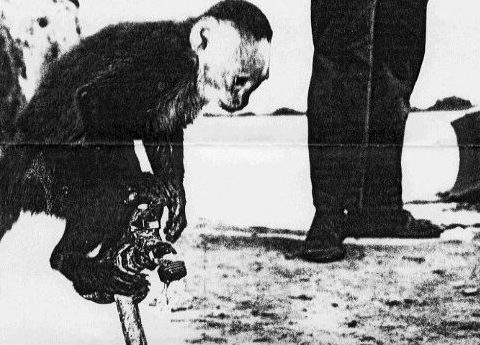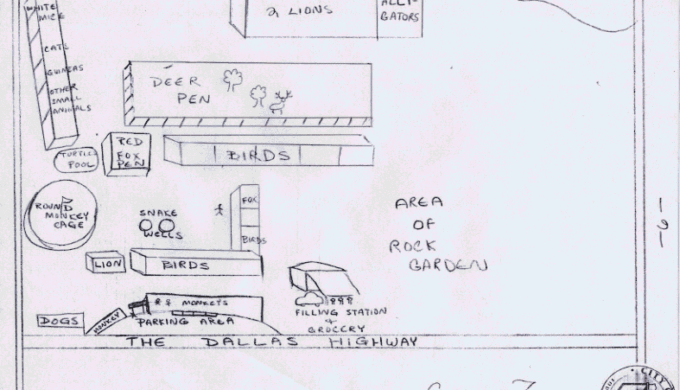In a state the size of Texas, it’s no surprise abandoned cities, buildings, and sites are all around. From the abandoned tin mines in El Paso to the now vacant airfields in Corpus Christi, to the ghost town of Center Point in east Texas, there’s no shortage of places to visit if you enjoy exploring these types of locations. But did you know there’s a unique abandoned destination right here in the Hill Country? Located on North Lamar Boulevard in Austin, (what used to be called the “Dallas Highway”), the remnants of the Coxville Zoo are a must-see for thrill seekers and historians alike.
History
The Forgotten History of the Abandoned Coxville Zoo
“… Just Look What One Monkey Started!”

Photo: tripod.com/Photos from the Coxville Zoo, 1942-1975
In 1936, Mr. and Mrs. Alvin W. Cox (along with Mr. and Mrs. M.J. Cox) purchased 55 acres of land about four miles north of Austin city limits, where they built a fueling station and convenience store. Not soon after, Alvin bought a pet monkey as a family pet, and the proverbial stage was set. “Junior” was such a hit at the gas station, soon customers were stopping by not for an oil change or loaf of bread, but to play and interact with the friendly primate. Seeing the impact Junior had on children and adults, Alvin began to acquire more animals, and in 1939, Coxville Zoo was established. He acquired some of the animals from soldiers who returned from overseas with exotic pets their wives refused to house. He obtained others from various businessmen who simply wanted a safe haven for exotic animals they had acquired. Alvin’s wife was quoted in a 1984 American Statesman article: “I know he always liked animals. But just look what one monkey started!”
“Twelve monkeys in the bathroom when my electric cage heater went off last winter almost lost me my wife!”

Photo: tripod.com/Schoolgirl’s Essay on the Coxville Zoo
By 1948, Alvin had acquired more animals than he could count. From turtle doves, parrots, and a pelican, to foxes, wolves, and bobcats, the zoo was truly an impressive menagerie of creatures big and small. He even had alligators placed right next to the lions’ cage! The upkeep of the zoo itself posed quite a challenge to the Cox’s. His parents, Mr. and Mrs. M. J. Cox, lived across the lake. It was Mrs. M.J. Cox who started the now infamous rock garden back in 1936. She continued to add unique rocks from all over the world to her garden. Mrs Cox would even mould miniature buildings and animals out of clay to set amongst the rocks. That same lake was the perfect respite from the Texas heat for all the visitors. The lake accorded boats and fresh-water fishing for all to enjoy. Life at the Coxville Zoo continued peacefully along for the next 21 years, with, of course, a hiccup here or there. One winter, the monkey’s electric cage heater failed, leaving Mr. Cox with no other choice but to harbor his precious primates in his home. As he laughingly put it, “Twelve monkeys in the bathroom… almost lost me my wife!”
“Don’t feed your hands to the animals.”

Photo: tripod.com/Photos from the Coxville Zoo, 1942-1975
It goes without saying that when you have a large animal population, you need to feed the large animal population. According to Alvin, in one week it took “374 pounds of meat, two barrels of bread, 100 pounds horse meat, and mule feed, 224 bananas, 100 pounds chicken scratch, grapes, peanuts, honey, cakes, cookies, and many other things.” Mr. Cox estimated it cost $32 a week to purchase the feed. Two donation cans were placed on either side of the entrance, where a wooden sign encouraged visitors to contribute to the cause. On average, the donations would total $12 a week. While he did not specifically discourage visitors from feeding the animals, he was often heard to quip, “(just) don’t feed your hands to the animals.”
Time Marches On

Photo: tripod.com/Recent Photos from the Coxville Zoo Site
On top of the monetary cost of the food, the upkeep of the cages was also a daily chore, one that took up much of the Cox’s time. Eventually, they leased out the fueling station to focus on the zoo. However, the rising cost of feed and upkeep, along with the installation of Interstate 35 (which rerouted traffic away from the zoo) forced the Cox’s to shutter the doors. All the animals were safely relocated to other zoos. Today, the remnants of the Coxville Zoo can still be found at the corner of Yager and North Lamar. The echoes of laughter from young and old alike can still be heard in this now abandoned area. While it may now just be a distant memory, Coxville Zoo will continue to live on through memories and pictures just like these.


